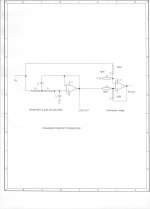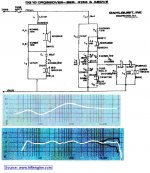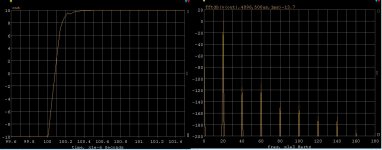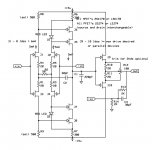I detected strains of rap in that, Frank.
Here is the antidote. You need to administer both of them in sequence.
Palladio - YouTube
I forgot to add the second one:
Karl Jenkins & Adiemus-Benedictus - YouTube
Read some of the comments. There's even one by someone called AmpDesign11.
I have to wait until my WA Sasha's are delivered, my new power amp design is added, driven by the CTC Blowtorch, before I get serious again.
Sounds like you really getting serious , good ..... 🙂
John , theres no reason for you not to have some serious skunk works amp at home listening to as your reference , design it , build it, let it sing ...
Something to make Sy drool again ....🙂
Something to make Sy drool again ....🙂
Last edited:
Actually, I am always designing something.
Since I lost my reference system over 20 years ago, in a firestorm, I have 'compromised' with the system that I can afford. Perhaps, soon, I will not have to compromise.
Since I lost my reference system over 20 years ago, in a firestorm, I have 'compromised' with the system that I can afford. Perhaps, soon, I will not have to compromise.
You like your Karl Jenkins, eh, Tom ... personally, all music is good to me - the magic when a system works properly is that you can listen to the most bizarre, outrageous music - and it all makes sense, you 'get' why the musicians did what they did, why it made sense to them at the time.I forgot to add the second one:
Karl Jenkins & Adiemus-Benedictus - YouTube
Read some of the comments. There's even one by someone called AmpDesign11.
If I really want to zone out, I have a New Age meditation 3 CD set, 'Drift Away' - makes the Benedictus sound like a Metallica concert ... 😉
You like your Karl Jenkins, eh, Tom ... personally, all music is good to me - the magic when a system works properly is that you can listen to the most bizarre, outrageous music - and it all makes sense, you 'get' why the musicians did what they did, why it made sense to them at the time.
If I really want to zone out, I have a New Age meditation 3 CD set, 'Drift Away' - makes the Benedictus sound like a Metallica concert ... 😉
Gak! New Age!
Quick!! Drink this!!
Captain Beyond ARMWORTH, MYOPIC VOID - YouTube
That takes me back, 🙂, I have a bootleg quality CD of Hoadley's Battle of the Sounds acts, early 70's The X Factor type of comp., that all do Spitting Image variations of that (type of) song.
But seriously - as I mentioned elsewhere - muso's can't help themselves - if you wind up the volume on that New Age material you discover it's full of Easter Eggs: all sorts of things are going on in the background, at very low volume; anyone listening at normal levels would never hear this happening. In fact, at times it moves towards being as busy and as interesting as that Zoolook material - but it's buried so far down in the mix that genteel replay would 100% hide it ...
But seriously - as I mentioned elsewhere - muso's can't help themselves - if you wind up the volume on that New Age material you discover it's full of Easter Eggs: all sorts of things are going on in the background, at very low volume; anyone listening at normal levels would never hear this happening. In fact, at times it moves towards being as busy and as interesting as that Zoolook material - but it's buried so far down in the mix that genteel replay would 100% hide it ...
Last Poets?
Wow, that brings back memories.
😀
Guess I'd better check Hoyt out ...
mlloyd1
Wow, that brings back memories.
😀
Guess I'd better check Hoyt out ...
mlloyd1
No answers, you guys obviously have an insider fight. Right now they are playing some degenerate Kraftwerk tunes, I'm groovin'.
EDIT - Time for some Last Poets censorship optional.
In about the mid-90's Audio Amateur (?), G. R. Koonce wrote up an elegant state variable derived electronic version of the Baekgaard "filler driver" approach to combining Linkwitz-Riley second order drivers in the same polarity. The electronic filter derives the woofer and filler signals and they're simply added in the right proportion and fed to the woofer. I'll find it tomorrow and post a reference. It's pretty cool.
All good fortune,
Chris
All good fortune,
Chris
Scott
Drive your DQ10s with a bit more powerful amplifier or at least beef-up the psu of your t-amp.
If you only look at the x-over schematic ( and touch the resistors while speaker operates), you'll realize the need for some current delivery from the amp.
George
Drive your DQ10s with a bit more powerful amplifier or at least beef-up the psu of your t-amp.
If you only look at the x-over schematic ( and touch the resistors while speaker operates), you'll realize the need for some current delivery from the amp.
George
Scott
Drive your DQ10s with a bit more powerful amplifier or at least beef-up the psu of your t-amp.
If you only look at the x-over schematic ( and touch the resistors while speaker operates), you'll realize the need for some current delivery from the amp.
George
The DQ-10's are gone, it's a long story but they got put out in the yard without my knowledge and left there in the winter weather for several months.
King Sound ESL
Describing those as line array, rather than line source, would be more accurate, imo.
The DQ-10's are gone, it's a long story but they got put out in the yard without my knowledge and left there in the winter weather for several months.
And you're still together?
I had a pair when they were newish and didn't get on with them......
Years later - about 10 years ago - a friend brought a pair around. They were very very good; but by then I had a decent amp and front end. IF a pair came up around here I would without hesitation buy them!
And you're still together?
I had a pair when they were newish and didn't get on with them......
Years later - about 10 years ago - a friend brought a pair around. They were very very good; but by then I had a decent amp and front end. IF a pair came up around here I would without hesitation buy them!
Sister inlaw, they even had Dick's ribbon tweeter upgrade. But as I said there were extenuating circumstances. I now have a pair NHT's just like SY's awaiting the reclaimation of my listening space (still suffering from woofer interuptus). I'll be back in February
Last edited:
I would like to return to the SIMPLE TP crossover, because it can give us an intuitive understanding of what 'phase shift' and 'group delay' is, actually.
Many decades ago, Richard Heyser, writing an AES Journal paper about speaker time alignment, stated three kinds of delay: Phase Delay, Group Delay, and REAL Delay.
I still don't completely understand what REAL Delay is.
But going back to the TP xover, I asked Richard Heyser to explain to me something that was missing in my understanding of phase shift, when it came to the TP Xover.
We built the Symmetry TP xover in 1977, and it did as advertised.
However, I could not understand HOW it did it so successfully.
You see, if you look at EITHER output, Hi or Low, they have delay. It can be computed with a computer, or looked up in the tables of a filter book, or whatever. YET, when the two 'delayed' outputs are added back together, the 'delay' DISAPPEARS! Where did the delay go? Now I know that some PhD's or their contemporaries might have known what happened to the delay, learning it in class at MIT or elsewhere, but I, then with 10 years of audio design, had missed that class, somehow, and it remained a mystery to me.
Richard Heyser patiently explained that phase shifted signal could be represented composed of a REAL and a 90 degree portion summed together. The polarity of each portion made a real difference in what it did with the signal. So, IF you could get the 90 degree portions to cancel each other with a simple - sign attached to one of them, then all you had left was the REAL contribution of the original signal. Elegant!
Coming up through the ranks of circuit understanding as a technician first, I had never thought through this concept. I suspect that several of you, as well, have not thought about it either.
Yesterday, when talking to Dick Sequerra about this problem, he started the SAME explanation that Richard Heyser did 35+ years ago. I hope that I have given some of you some added insight about the nature of phase shift and delay.
Many decades ago, Richard Heyser, writing an AES Journal paper about speaker time alignment, stated three kinds of delay: Phase Delay, Group Delay, and REAL Delay.
I still don't completely understand what REAL Delay is.
But going back to the TP xover, I asked Richard Heyser to explain to me something that was missing in my understanding of phase shift, when it came to the TP Xover.
We built the Symmetry TP xover in 1977, and it did as advertised.
However, I could not understand HOW it did it so successfully.
You see, if you look at EITHER output, Hi or Low, they have delay. It can be computed with a computer, or looked up in the tables of a filter book, or whatever. YET, when the two 'delayed' outputs are added back together, the 'delay' DISAPPEARS! Where did the delay go? Now I know that some PhD's or their contemporaries might have known what happened to the delay, learning it in class at MIT or elsewhere, but I, then with 10 years of audio design, had missed that class, somehow, and it remained a mystery to me.
Richard Heyser patiently explained that phase shifted signal could be represented composed of a REAL and a 90 degree portion summed together. The polarity of each portion made a real difference in what it did with the signal. So, IF you could get the 90 degree portions to cancel each other with a simple - sign attached to one of them, then all you had left was the REAL contribution of the original signal. Elegant!
Coming up through the ranks of circuit understanding as a technician first, I had never thought through this concept. I suspect that several of you, as well, have not thought about it either.
Yesterday, when talking to Dick Sequerra about this problem, he started the SAME explanation that Richard Heyser did 35+ years ago. I hope that I have given some of you some added insight about the nature of phase shift and delay.
Attachments
Last edited:
The DQ-10's are gone, it's a long story but they got put out in the yard without my knowledge and left there in the winter weather for several months.
Sorry to hear that (and my apologies for my misunderstanding).
Nevertheless, here is the x-over circuit and the published impedance curve.
Note the paired series topology and the low value resistors utilized for smoothing the impedance peaks.
George
Attachments
While listening last night I fiddled around with my circuit. The lower gm version makes more sense for low closed-loop gain applications. Here is a quick version that goes down to 6dB. This might not be perfectly optimum but one suggestion for starters. Pretty good full step response (130v/us) and THD at 20V and 20K still in ppm's (2K load). At normal signal levels should be low ppm distortions. Remember this was an exercise in taking JC's classic and using it in a conventional op-amp context (126dB Aol, 30Hz OLBW, etc.).
Attachments
Last edited:
John,
It sounds like you might be talking about the "I and Q" representation of signals, i.e. "In-phase and Quadrature".
If you want to learn more, search for it that way, maybe adding the word "tutorial".
Tom
It sounds like you might be talking about the "I and Q" representation of signals, i.e. "In-phase and Quadrature".
If you want to learn more, search for it that way, maybe adding the word "tutorial".
Tom
Thanks Gootee, I appreciate the tip. However, my biggest interest is getting an 'intuitive' understanding of phase shift in all sorts of filters, both simple and complex, rather than the mathematical manipulation of them.
When I first went to work at Ampex in 1967, I was strong in math, but weak in knowledge of filter theory. My first task was calculating phase shifters for instrumentation tape recorders, a job high in math, but I never could completely understand what I was doing. I think that understanding trumps heavy math.
When I first went to work at Ampex in 1967, I was strong in math, but weak in knowledge of filter theory. My first task was calculating phase shifters for instrumentation tape recorders, a job high in math, but I never could completely understand what I was doing. I think that understanding trumps heavy math.
Richard Heyser patiently explained that phase shifted signal could be represented composed of a REAL and a 90 degree portion summed together. The polarity of each portion made a real difference in what it did with the signal. So, IF you could get the 90 degree portions to cancel each other with a simple - sign attached to one of them, then all you had left was the REAL contribution of the original signal. Elegant!
Interesting, JC. I have a patent for a very wide bandwidth rejection filter design that I used this exact same principle of using the phase angles to do the work and obtaining the filter response you want. [different application, though -- ac power line app]. It was just intuitive to me. Works very well, too. I would expect an audio crossover which used same principle to work very well also.
Thx-RNMarsh
Last edited:
- Status
- Not open for further replies.
- Home
- Member Areas
- The Lounge
- John Curl's Blowtorch preamplifier part II



